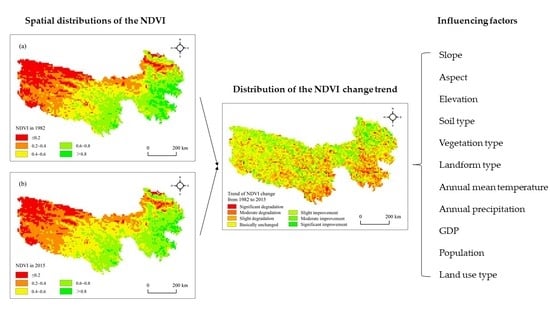Quantification of Natural and Anthropogenic Driving Forces of Vegetation Changes in the Three-River Headwater Region during 1982–2015 Based on Geographical Detector Model
Abstract
:1. Introduction
2. Materials and Methods
2.1. Study Area
2.2. Data and Processing
2.3. Methods
2.3.1. Linear Regression Analysis
2.3.2. Mann-Kendall Test
2.3.3. Moving t-Test
2.3.4. Geographical Detector
3. Results
3.1. Spatial and Temporal Variation Characteristics of the NDVI in the TRHR
3.2. Trend Analysis of NDVI Changes in the TRHR
3.3. Factor Detection
3.4. Ecological Detection
3.5. Interaction Detection
3.6. Risk Detection
3.6.1. Annual Precipitation
3.6.2. Annual Mean Temperature
3.6.3. Vegetation Type
3.6.4. Elevation
3.6.5. Land Use Type
3.6.6. Synergistic Effects of Other Factors
4. Discussion
4.1. Effects of Natural Factors
4.2. Effects of Anthropogenic Factors
4.3. Effectiveness, Limitations, and Future Directions
5. Conclusions
Author Contributions
Funding
Data Availability Statement
Acknowledgments
Conflicts of Interest
Appendix A
| Area/km² | Cropland | Forest Land | High-Coverage Grassland | Middle-Coverage Grassland | Low-Coverage Grassland | Water Area | Construction Land | Unused Land | 2015 Total |
|---|---|---|---|---|---|---|---|---|---|
| Cropland | 2010.75 | 0.00 | 0.00 | 232.85 | 2.41 | 0.00 | 0.00 | 0.00 | 2246.01 |
| Forest land | 0.00 | 14,805.10 | 0.00 | 20.44 | 30.61 | 0.00 | 0.00 | 0.00 | 14,856.15 |
| High-coverage grassland | 78.42 | 0.00 | 20,236.10 | 254.87 | 156.84 | 0.00 | 0.00 | 80.83 | 20,807.07 |
| Middle-coverage grassland | 0.00 | 71.34 | 78.42 | 93,372.20 | 1250.00 | 0.28 | 0.00 | 160.96 | 94,933.20 |
| Low-coverage grassland | 78.42 | 80.83 | 19.61 | 663.11 | 141,923.00 | 225.49 | 0.00 | 182.09 | 143,172.54 |
| Water area | 313.68 | 0.00 | 0.00 | 50.22 | 8.78 | 16,702.20 | 0.00 | 289.61 | 17,364.50 |
| Construction land | 78.42 | 0.00 | 0.00 | 156.84 | 0.00 | 0.00 | 78.42 | 0.00 | 313.68 |
| Unused land | 0.00 | 0.00 | 30.61 | 346.55 | 738.81 | 414.77 | 0.00 | 85,102.60 | 86,633.34 |
| 1980 Total | 2559.70 | 14,957.27 | 20,364.74 | 95,097.07 | 144,110.46 | 17,342.74 | 78.42 | 85,816.09 | |
| Area change | −313.69 | −101.12 | 442.33 | −163.87 | −937.92 | 21.76 | 235.26 | 817.25 |

References
- Zhao, L.; Dai, A.G.; Dong, B. Changes in global vegetation activity and its driving factors during 1982–2013. Agric. For. Meteorol. 2018, 249, 198–209. [Google Scholar] [CrossRef]
- Pettorelli, N.; Vik, J.O.; Mysterud, A.; Gaillard, J.M.; Tucker, C.J.; Stenseth, N.C. Using the satellite-derived NDVI to assess ecological responses to environmental change. Trends Ecol. Evol. 2005, 20, 503. [Google Scholar] [CrossRef] [PubMed]
- Fensholt, R.; Langanke, T.; Rasmussen, K.; Reenberg, A.; Prince, S.D.; Tucker, C.; Scholes, R.J.; Le, Q.B.; Bondeau, A.; Eastman, R.; et al. Greenness in semi-arid areas across the globe 1981–2007—An Earth Observing Satellite based analysis of trends and drivers. Remote Sens. Environ. 2012, 121, 144–158. [Google Scholar] [CrossRef]
- Liu, Y.; Li, Y.; Li, S.H.; Motesharrei, S. Spatial and Temporal Patterns of Global NDVI Trends: Correlations with Climate and Human Factors. Remote Sens. 2015, 7, 13233–13250. [Google Scholar] [CrossRef] [Green Version]
- Jiang, L.L.; Jiapaer, G.; Bao, A.M.; Guo, H.; Ndayisaba, F. Vegetation dynamics and responses to climate change and human activities in Central Asia. Sci. Total Environ. 2017, 599–600. [Google Scholar] [CrossRef]
- Gong, Z.N.; Zhao, S.Y.; Gu, J.Z. Correlation analysis between vegetation coverage and climate drought conditions in North China during 2001–2013. J. Geogr. Sci. 2017, 27, 143–160. [Google Scholar] [CrossRef]
- Hu, Y.F.; Dao, R.N.; Hu, Y. Vegetation Change and Driving Factors: Contribution Analysis in the Loess Plateau of China during 2000–2015. Sustainability 2019, 11, 1320. [Google Scholar] [CrossRef] [Green Version]
- Huang, K.; Zhang, Y.J.; Zhu, J.T.; Liu, Y.J.; Zu, J.X.; Zhang, J. The Influences of Climate Change and Human Activities on Vegetation Dynamics in the Qinghai-Tibet Plateau. Remote Sens. 2016, 8, 876. [Google Scholar] [CrossRef] [Green Version]
- Qu, S.; Wang, L.C.; Lin, A.W.; Zhu, H.J.; Yuan, M.X. What drives the vegetation restoration in Yangtze River basin, China: Climate change or anthropogenic factors. Scientidicators 2018, 90, 438–450. [Google Scholar] [CrossRef]
- Chu, H.S.; Venevsky, S.; Wu, C.; Wang, M.H. NDVI-based vegetation dynamics and its response to climate changes at Amur-Heilongjiang River Basin from 1982 to 2015. Sci. Total Environ. 2018, 650 Pt 2, 2051–2062. [Google Scholar] [CrossRef]
- Wang, J.F.; Xu, C.D. Geodetector: Principle and prospective. Acta Geogr. Sin. 2017, 72, 116–134. (In Chinese) [Google Scholar]
- Zhao, W.; Hu, Z.M.; Guo, Q.; Wu, G.N.; Chen, R.R.; Li, S.G. Contributions of Climatic Factors to Interannual Variability of the Vegetation Index in Northern China Grasslands. J. Clim. 2020, 33, 175–183. [Google Scholar] [CrossRef]
- Yuan, L.H.; Chen, X.Q.; Wang, X.Y.; Xiong, Z.; Song, C.Q. Spatial associations between NDVI and environmental factors in the Heihe River Basin. J. Geogr. Sci. 2019, 29, 1548–1564. [Google Scholar] [CrossRef] [Green Version]
- Zhu, L.J.; Meng, J.J.; Zhu, L.K. Applying Geodetector to disentangle the contributions of natural and anthropogenic factors to NDVI variations in the middle reaches of the Heihe River Basin. Ecol. Indic. 2020, 117, 106545. [Google Scholar] [CrossRef]
- Ran, Q.W.; Hao, Y.B.; Xia, A.Q.; Liu, W.J.; Hu, R.H.; Cui, X.Y.; Xue, K.; Song, X.N.; Xu, C.; Ding, B.Y.; et al. Quantitative Assessment of the Impact of Physical and Anthropogenic Factors on Vegetation Spatial-Temporal Variation in Northern Tibet. Remote Sens. 2019, 11, 1183. [Google Scholar] [CrossRef] [Green Version]
- Zhang, Y.; Zhang, K.C.; An, Z.S.; Yu, Y.P. Quantification of driving factors on NDVI in oasis-desert ecotone using geographical detector method. J. Mt. Sci. 2019, 16, 2615–2624. [Google Scholar] [CrossRef]
- Liu, Y.X.; Liu, S.L.; Sun, Y.X.; Li, M.Q.; An, Y.; Shi, F.N. Spatial differentiation of the NPP and NDVI and its influencing factors vary with grassland type on the Qinghai-Tibet Plateau. Environ. Monit. Assess. 2021, 193, 48. [Google Scholar] [CrossRef]
- Liu, J.Y.; Xu, X.L.; Shao, Q.Q. Grassland degradation in the “Three-River Headwaters” region, Qinghai Province. J. Geogr. Sci. 2008, 18, 259–273. [Google Scholar] [CrossRef]
- Wang, R.; Dong, Z.B.; Zhou, Z.C. Changes in the depths of seasonal freezing and thawing and their effects on vegetation in the Three-River Headwater Region of the Tibetan Plateau. J. Mt. Sci. 2019, 16, 2810–2827. [Google Scholar] [CrossRef]
- Bai, Y.F.; Guo, C.C.; Degen, A.A.; Ahmad, A.A.; Wang, W.Y.; Zhang, T.; Li, W.Y.; Ma, L.; Huang, M.; Zeng, H.J.; et al. Climate warming benefits alpine vegetation growth in Three-River Headwater Region, China. Sci. Total Environ. 2020, 742, 140574. [Google Scholar] [CrossRef]
- Pang, G.J.; Wang, X.J.; Yang, M.X. Using the NDVI to identify variations in, and responses of, vegetation to climate change on the Tibetan Plateau from 1982 to 2012. Quat. Int. 2016, 444 Pt A, 87–96. [Google Scholar] [CrossRef]
- Jiang, C.; Zhang, L.B. Climate Change and Its Impact on the Eco-Environment of the Three-Rivers Headwater Region on the Tibetan Plateau, China. Int. J. Environ. Res. Public Health 2015, 12, 12057–12081. [Google Scholar] [CrossRef] [PubMed] [Green Version]
- Li, F.X.; Li, X.D.; Zhou, B.R.; Qi, D.L.; Wang, L.; Fu, H. Effects of grazing intensity on biomass and soil physical and chemical characteristics in alpine meadow in the source of three rivers. Pratacultural Sci. 2015, 32, 11–18. (In Chinese) [Google Scholar]
- Pinzon, J.E.; Tucker, C.J. A non-stationary 1981–2012 AVHRR NDVI3g time series. Remote Sens. 2014, 6, 6929–6960. [Google Scholar] [CrossRef] [Green Version]
- National Oceanic and Atmospheric Administration. GIMMS NDVI3g dataset for Sanjiangyuan (1982–2015). A Big Earth Data Platf. Three Poles 2018. CSTR: 18406.11.Ecolo.tpdc.271224. [CrossRef]
- Holben, B.N. Characteristics of maximum-value composite images from temporal AVHRR data. Int. J. Remote Sens. 1986, 7, 1417–1434. [Google Scholar] [CrossRef]
- Wei, Y.Q. Establishing Developing and Applying of the Space-Air-Field Integrated Eco-Monitoring and Data Infrastructure of the Three-River-Source National Park. The boundaries of the source regions in Sanjiangyuan region (2018). A Big Earth Data Platf. Three Poles 2018. CSTR: 18406.11.Geogra.tpdc.270009. [Google Scholar] [CrossRef]
- Feng, J.M.; Dong, B.Q.; Qin, T.L.; Liu, S.S.; Zhang, J.W.; Gong, X.F. Temporal and Spatial Variation Characteristics of NDVI and Its Relationship with Environmental Factors in Huangshui River Basin from 2000 to 2018. Pol. J. Environ. Stud. 2021, 30, 3043–3063. [Google Scholar] [CrossRef]
- Peng, W.F.; Kuang, T.T.; Tao, S. Quantifying influences of natural factors on vegetation NDVI changes based on geographical detector in Sichuan, western China. J. Clean. Prod. 2019, 233, 353–367. [Google Scholar] [CrossRef]
- Nie, T.; Dong, G.T.; Jiang, X.H.; Lei, Y.X. Spatio-Temporal Changes and Driving Forces of Vegetation Coverage on the Loess Plateau of Northern Shaanxi. Remote Sens. 2021, 13, 613. [Google Scholar] [CrossRef]
- Liu, Y.S.; Li, J.T. Geographic detection and optimizing decision of the differentiation mechanism of rural poverty in China. Acta Geogr. Sin. 2017, 72, 161–173. (In Chinese) [Google Scholar]
- Jiao, K.W.; Gao, J.B.; Wu, S.H. Climatic determinants impacting the distribution of greenness in China: Regional differentiation and spatial variability. Int. J. Biometeorol. 2019, 63, 523–533. [Google Scholar] [CrossRef]
- Feng, X.Q.; Zhang, G.X.; Yin, X.R. Hydrological Responses to Climate Change in Nenjiang River Basin, Northeastern China. Water Resour. Manag. 2011, 25, 677–689. [Google Scholar] [CrossRef]
- Liu, H.Y.; Jiao, F.S.; Yin, J.Q.; Li, T.Y.; Gong, H.B.; Wang, Z.Y.; Lin, Z.S. Nonlinear relationship of vegetation greening with nature and human factors and its forecast—A case study of Southwest China. Ecol. Indic. 2020, 111, 106009. [Google Scholar] [CrossRef]
- Du, R.S.; Shang, F.H.; Ma, N. Automatic mutation feature identification from well logging curves based on sliding t test algorithm. Clust. Comput. 2019, 22, 14193–14200. [Google Scholar] [CrossRef]
- Zhai, X.H.; Liang, X.L.; Yan, C.Z.; Xing, X.G.; Jia, H.W.; Wei, X.X.; Feng, K. Vegetation Dynamic Changes and Their Response to Ecological Engineering in the Sanjiangyuan Region of China. Remote Sens. 2020, 12, 4035. [Google Scholar] [CrossRef]
- Rao, P.Z.; Wang, Y.C.; Wang, F. Analysis on the NDVI Change and Influence Factors of Vegetation Cover in the Three-River Headwaters Region. Acta Agrestia Sin. 2021, 29, 572–582. (In Chinese) [Google Scholar]
- Wang, H.; Yan, S.J.; Liang, Z.; Jiao, K.W.; Li, D.L.; Wei, F.L.; Li, S.C. Strength of association between vegetation greenness and its drivers across China between 1982 and 2015: Regional differences and temporal variations. Ecol. Indic. 2021, 128, 107831. [Google Scholar] [CrossRef]
- Lin, X.N.; Niu, J.Z.; Berndtsson, R.; Yu, X.X.; Zhang, L.; Chen, X.W. NDVI Dynamics and Its Response to Climate Change and Reforestation in Northern China. Remote Sens. 2020, 12, 4138. [Google Scholar] [CrossRef]
- Piao, S.L.; Cui, M.D.; Chen, A.P.; Wang, X.H.; Ciais, P.; Liu, J.; Tang, Y.H. Altitude and temperature dependence of change in the spring vegetation green-up date from 1982 to 2006 in the Qinghai-Xizang Plateau. Agric. For. Meteorol. 2011, 151, 1599–1608. [Google Scholar] [CrossRef]
- Li, W.H. An Overview of Ecological Research Conducted on the Qinghai-Tibetan Plateau. J. Resour. Ecol. 2017, 8, 1–4. [Google Scholar]
- Chen, C.; Li, T.J.; Sivakumar, B.; Li, J.Y.; Wang, G.Q. Attribution of growing season vegetation activity to climate change and human activities in the Three-River Headwaters Region, China. J. Hydroinform. 2020, 22, 186–204. [Google Scholar] [CrossRef]
- Zheng, Y.T.; Han, J.C.; Huang, Y.F.; Fassnacht, S.R.; Xie, S.; Lv, E.Z.; Chen, M. Vegetation response to climate conditions based on NDVI simulations using stepwise cluster analysis for the Three-River Headwaters region of China. Ecol. Indic. 2018, 92, 18–29. [Google Scholar] [CrossRef]
- Xiong, Q.L.; Xiao, Y.; Halmy, M.W.; Dakhil, M.A.; Liang, P.H.; Liu, C.G.; Zhang, L.; Pandey, B.; Pan, K.W.; Kafraway, S.B.; et al. Monitoring the impact of climate change and human activities on grassland vegetation dynamics in the northeastern Qinghai-Tibet Plateau of China during 2000–2015. J. Arid Land 2019, 11, 637–651. [Google Scholar] [CrossRef] [Green Version]
- Xu, W.X.; Gu, S.; Zhao, X.Q.; Xiao, J.S.; Tang, Y.H.; Fang, J.Y.; Zhang, J.; Jiang, S. High positive correlation between soil temperature and NDVI from 1982 to 2006 in alpine meadow of the Three-River Source Region on the Qinghai-Tibetan Plateau. Int. J. Appl. Earth Obs. Geoinf. 2011, 13, 528–535. [Google Scholar] [CrossRef]
- Zhu, W.H.; Mao, F.; Xu, Y.; Zheng, J.; Song, L.X. Analysis on response of vegetation index to climate change and its prediction in the Three-Rivers-Source region. Plateau Meteorol. 2019, 38, 693–704. (In Chinese) [Google Scholar]
- Bai, X.L.; Wei, J.H.; Xie, H.W. Characteristics of wetness/dryness variation and their influences in the Three-River Headwaters region. Acta Ecol. Sin. 2017, 37, 8397–8410. (In Chinese) [Google Scholar]
- Sun, J.; Cheng, G.W.; Li, W.P.; Sha, Y.K.; Yang, Y.C. On the Variation of NDVI with the Principal Climatic Elements in the Tibetan Plateau. Remote Sens. 2013, 5, 1894–1911. [Google Scholar] [CrossRef] [Green Version]
- Meng, X.H.; Chen, H.; Li, Z.G.; Zhao, L.R.; Lu, S.H.; Deng, M.S.; Liu, Y.M.; Li, G.W. Review of Climate Change and Its Environmental Influence on the Three-River Regions. Plateau Meteorol. 2020, 39, 1133–1143. (In Chinese) [Google Scholar]
- Cao, L.; Pan, S. Changes in precipitation extremes over the “Three-River headwaters” region, hinterland of the Tibetan plateau, during 1960–2012. Quat. Int. 2014, 321, 105–115. [Google Scholar] [CrossRef]
- Zhong, L.; Ma, Y.M.; Salama, M.S.; Su, Z.B. Assessment of vegetation dynamics and their response to variations in precipitation and temperature in the Tibetan Plateau. Clim. Chang. 2010, 103, 519–535. [Google Scholar] [CrossRef]
- Liu, D.; Wang, T.; Yang, T.; Yan, Z.J.; Liu, Y.W.; Zhao, Y.T.; Piao, S.L. Deciphering impacts of climate extremes on Tibetan grasslands in the last fifteen years. Sci. Bull. 2019, 64, 446–454. [Google Scholar] [CrossRef] [Green Version]
- Liu, X.F.; Zhang, J.S.; Zhu, X.F. Spatiotemporal changes in vegetation coverage and its driving factors in the Three-River Headwaters Region during 2000–2011. J. Geogr. Sci. 2014, 24, 288–302. [Google Scholar] [CrossRef]
- Yi, X.S.; Li, G.S.; Yin, Y.Y. Spatio-temporal variation of precipitation in the Three-River Headwater Region from 1961 to 2010. J. Geogr. Sci. 2013, 23, 447–464. [Google Scholar] [CrossRef]
- Wang, H.N.; Lv, X.Z.; Zhang, M.Y. Sensitivity and attribution analysis of vegetation changes on evapotranspiration with the Budyko framework in the Baiyangdian catchment, China. Ecol. Indic. 2021, 120, 106963. [Google Scholar] [CrossRef]
- Kumari, N.; Srivastava, A.; Dumka, U.C. A Long-Term Spatiotemporal Analysis of Vegetation Greenness over the Himalayan Region Using Google Earth Engine. Climate 2021, 9, 109. [Google Scholar] [CrossRef]
- Shao, Q.Q.; Cao, W.; Fan, J.W.; Huang, L.; Xu, X.L. Effects of an ecological conservation and restoration project in the Three-River Source Region, China. J. Geogr. Sci. 2017, 27, 183–204. [Google Scholar] [CrossRef]
- Jiang, C.; Zhang, L.B. Ecosystem change assessment in the Three-river Headwater Region, China: Patterns, causes, and implications. Ecol. Eng. 2016, 93, 24–36. [Google Scholar] [CrossRef]
- Chen, Q.; Zhou, Q.; Zhang, H.F.; Liu, F.G. Spatial disparity of NDVI response in vegetation growing season to climate change in the Three-River Headwaters region. Ecol. Environ. Sci. 2010, 19, 1284–1289. (In Chinese) [Google Scholar]
- Liu, M.X.; Wang, G. Responses of plant community diversity and soil factors to slope aspect in alpine meadow. Chin. J. Ecol. 2013, 32, 259–265. (In Chinese) [Google Scholar]
- Shen, X.J.; An, R.; Feng, L.; Ye, N.; Zhu, L.J.; Li, M.H. Vegetation changes in the Three-River Headwaters Region of the Tibetan Plateau of China. Ecol. Indic. 2018, 93, 804–812. [Google Scholar] [CrossRef]
- Wang, S.H.; Jia, S.F.; Lv, A.F. The relationship be- tween NDVI and residential sites across Three-River-Source area. Resour. Sci. 2012, 34, 2045–2050. (In Chinese) [Google Scholar]
- Hein, L.; de Ridder, N.; Hiernaux, P.; Leemans, R.; de Witd, A.; Schaepman, M. Desertification in the Sahel: Towards better accounting for ecosystem dynamics in the interpretation of remote sensing images. J. Arid Environ. 2011, 75, 1164–1172. [Google Scholar] [CrossRef]
- Meng, X.Y.; Gao, X.; Li, S.Y.; Lei, J.Q. Spatial and Temporal Characteristics of Vegetation NDVI Changes and the Driving Forces in Mongolia during 1982–2015. Remote Sens. 2020, 12, 603. [Google Scholar] [CrossRef] [Green Version]
- Yu, G.; Zhang, X.Y.; Wang, Q.B.; Chen, H.K.; Du, X.Y.; Ma, Y.P. Temporal changes in vegetation around a shale gas development area in a subtropical karst region in southwestern China. Sci. Total Environ. 2020, 701, 134769. [Google Scholar]
- Huete, A.; Didan, K.; Miura, K.; Rodriguez, E.P.; Gao, X.; Ferreira, L.G. Overview of the radiometric and biophysical performance of the MODIS vegetation indices. Remote Sens. Environ. 2002, 83, 195–213. [Google Scholar] [CrossRef]
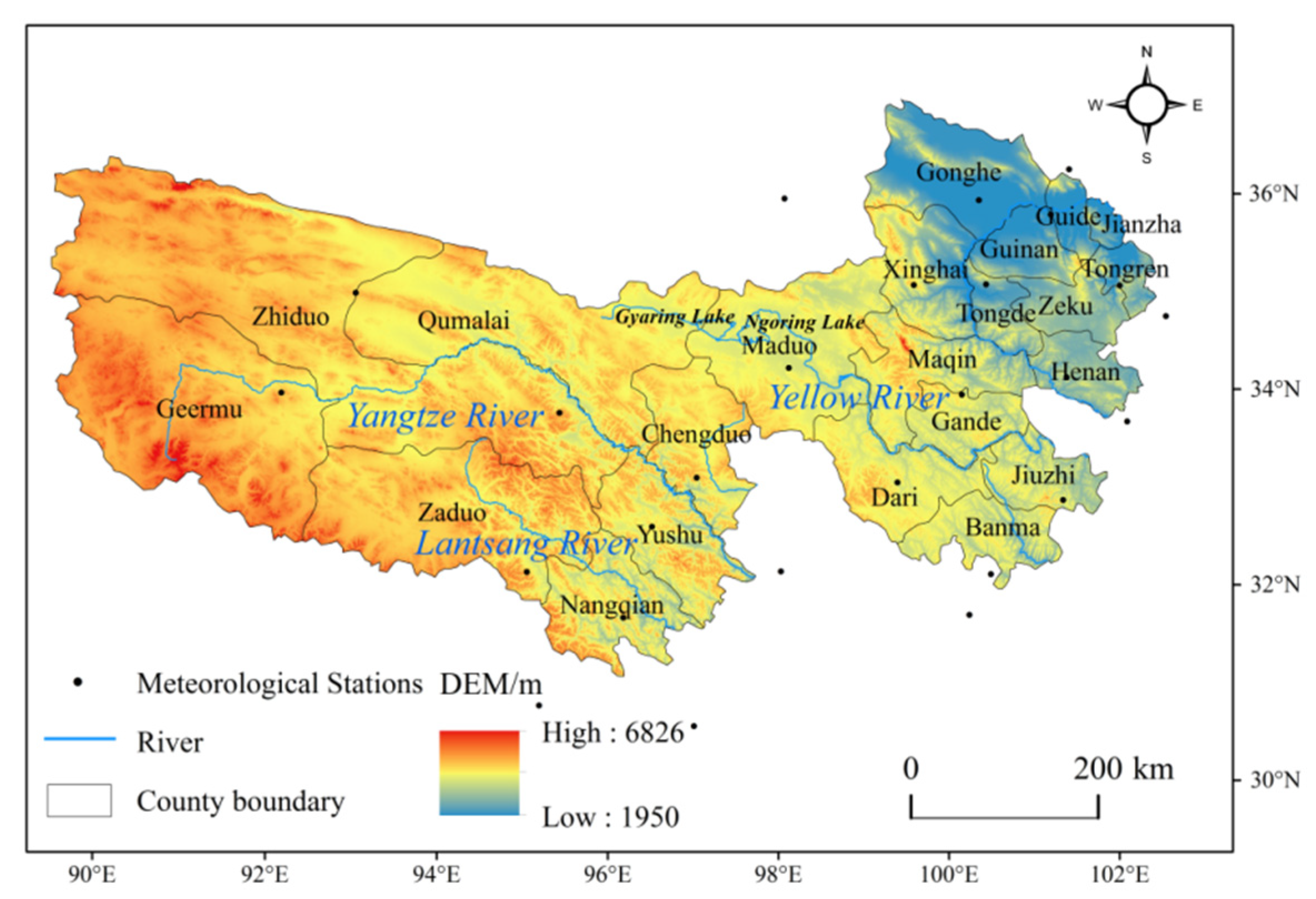
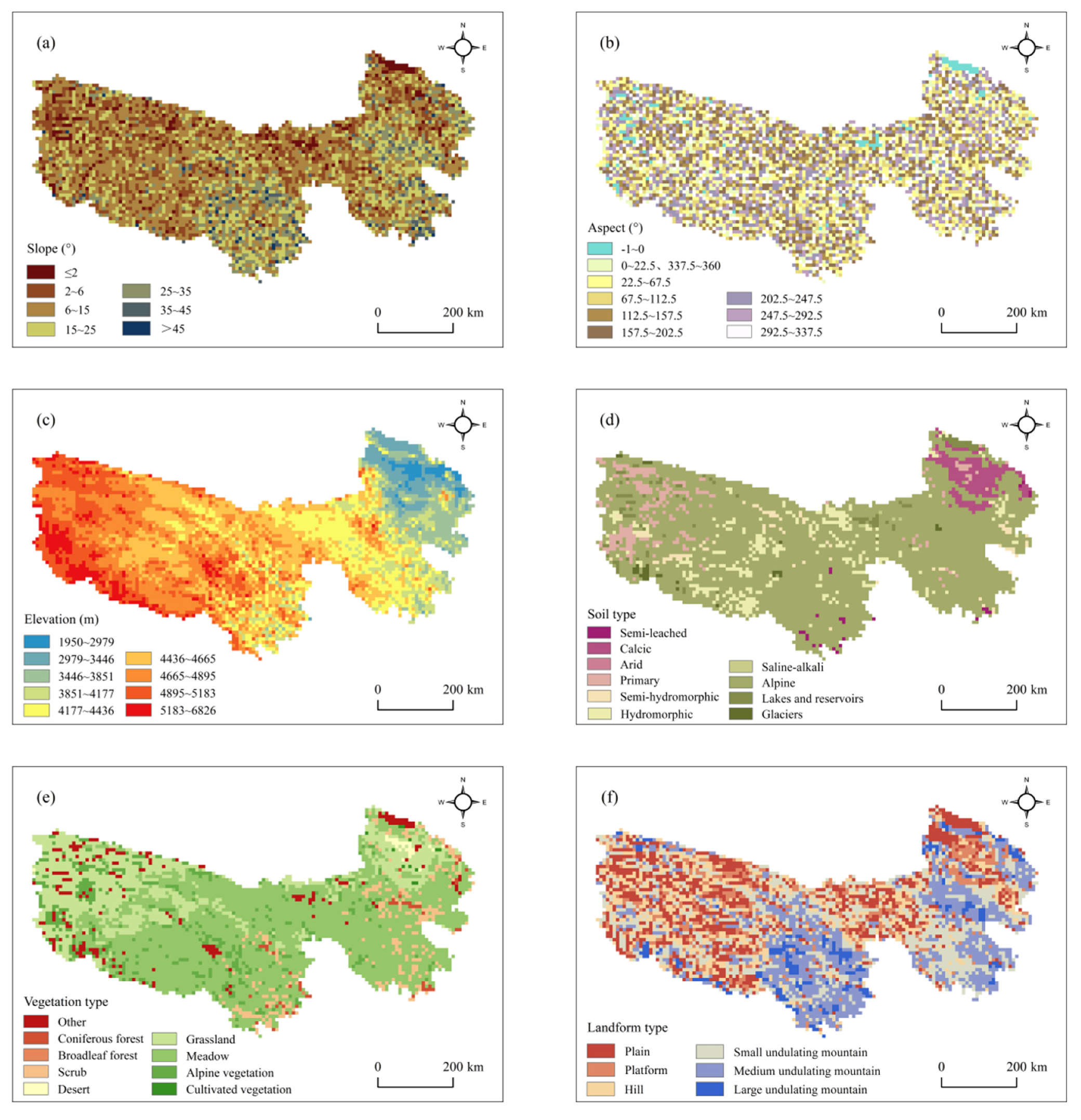
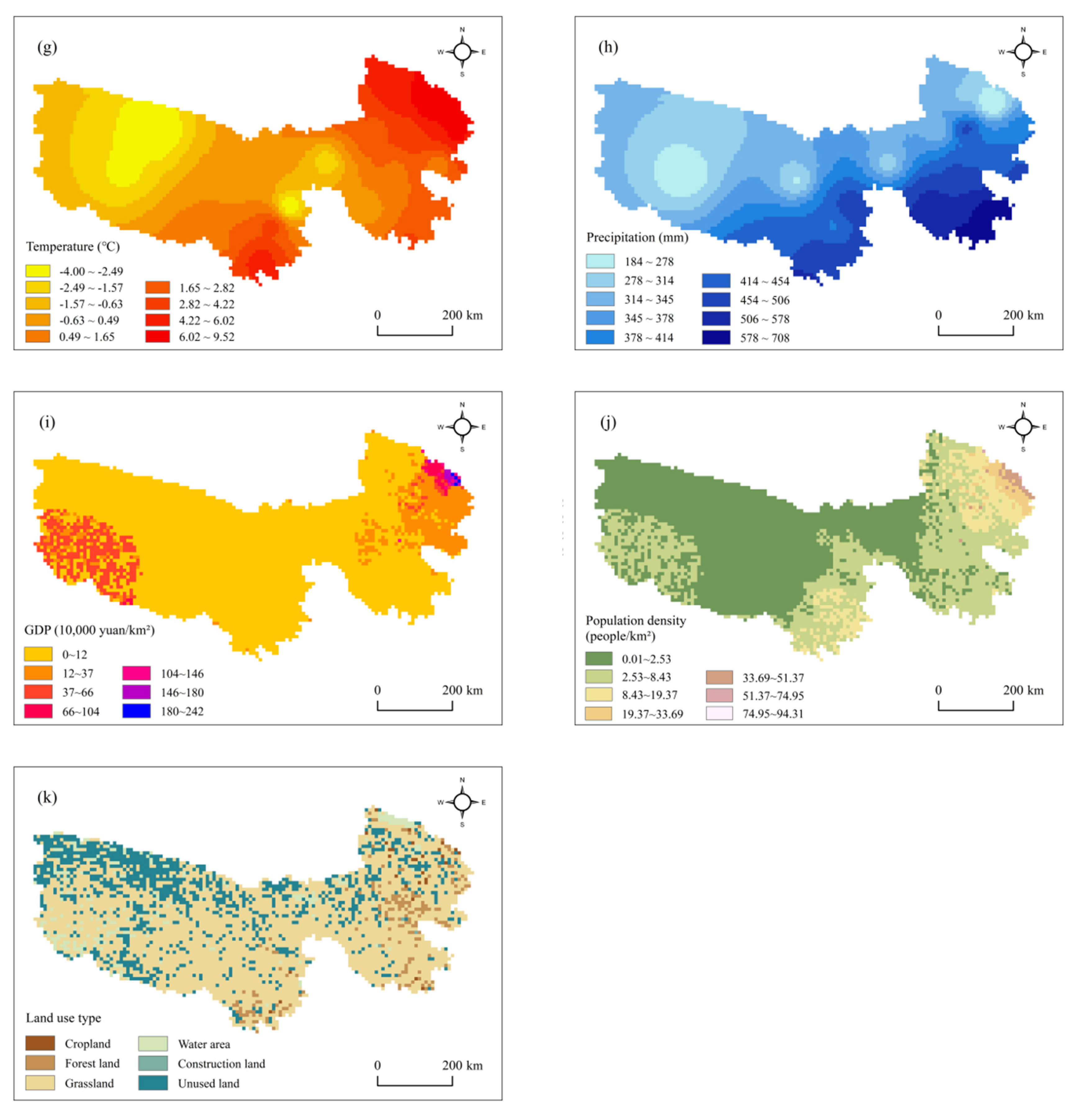

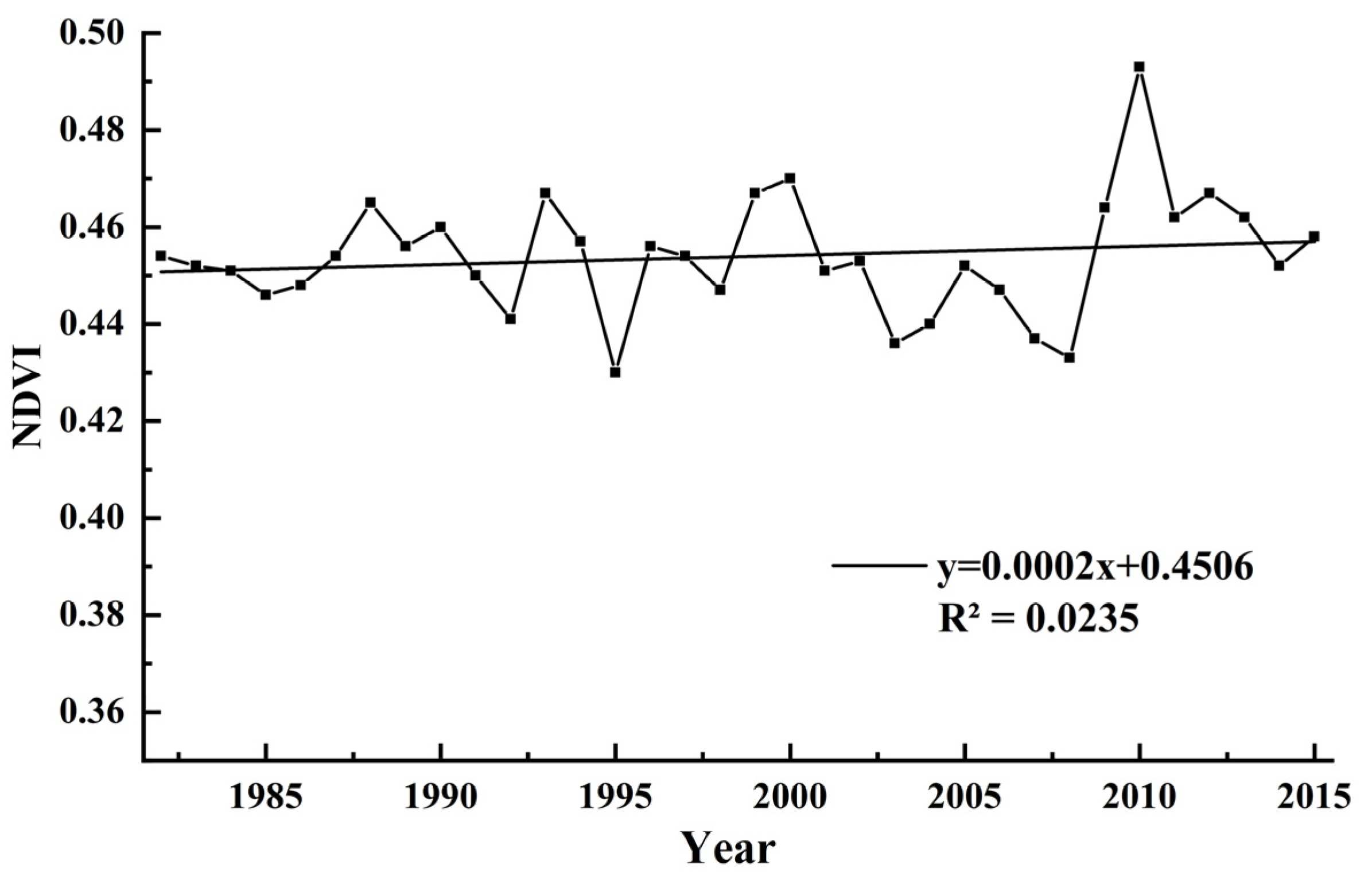
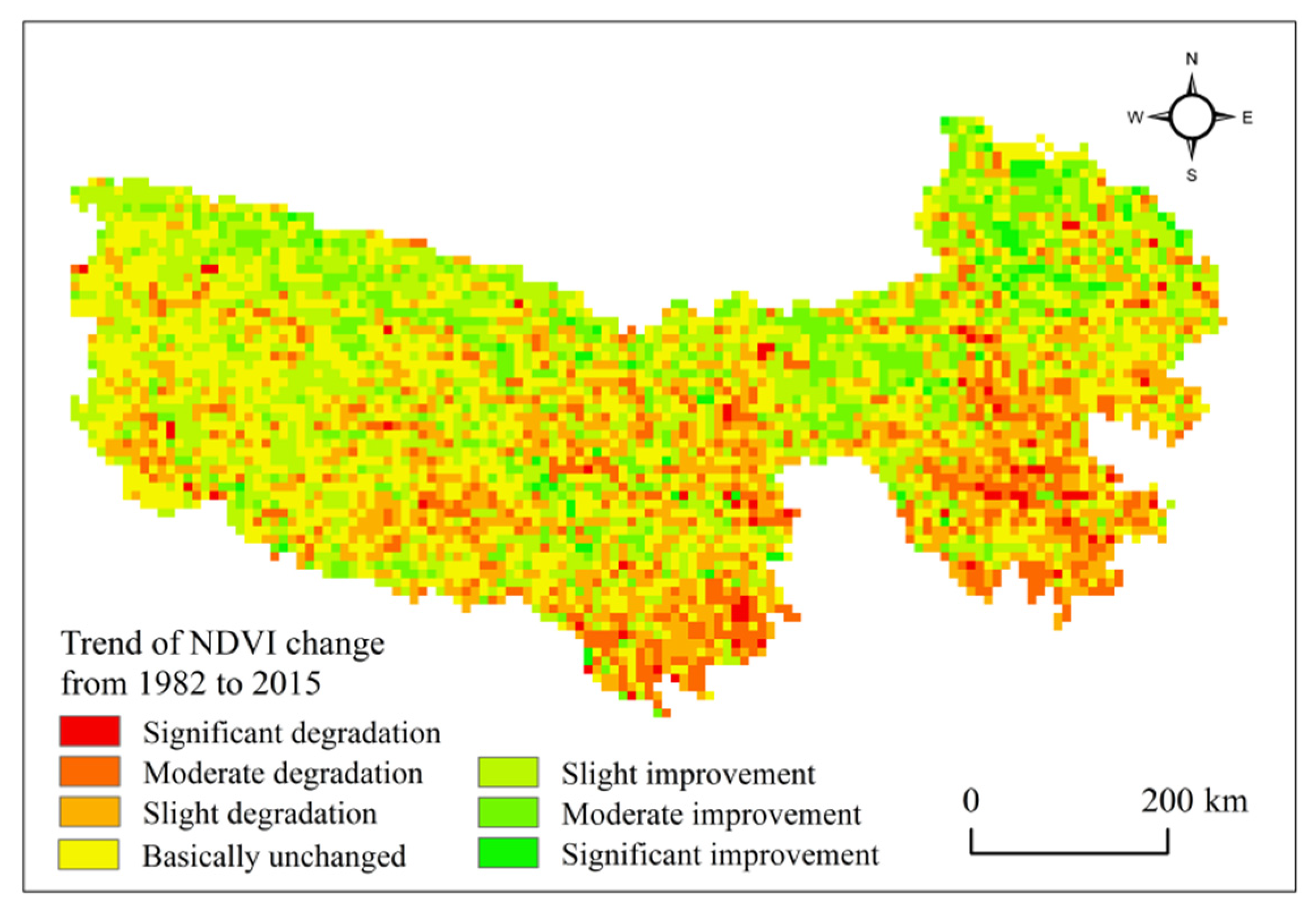
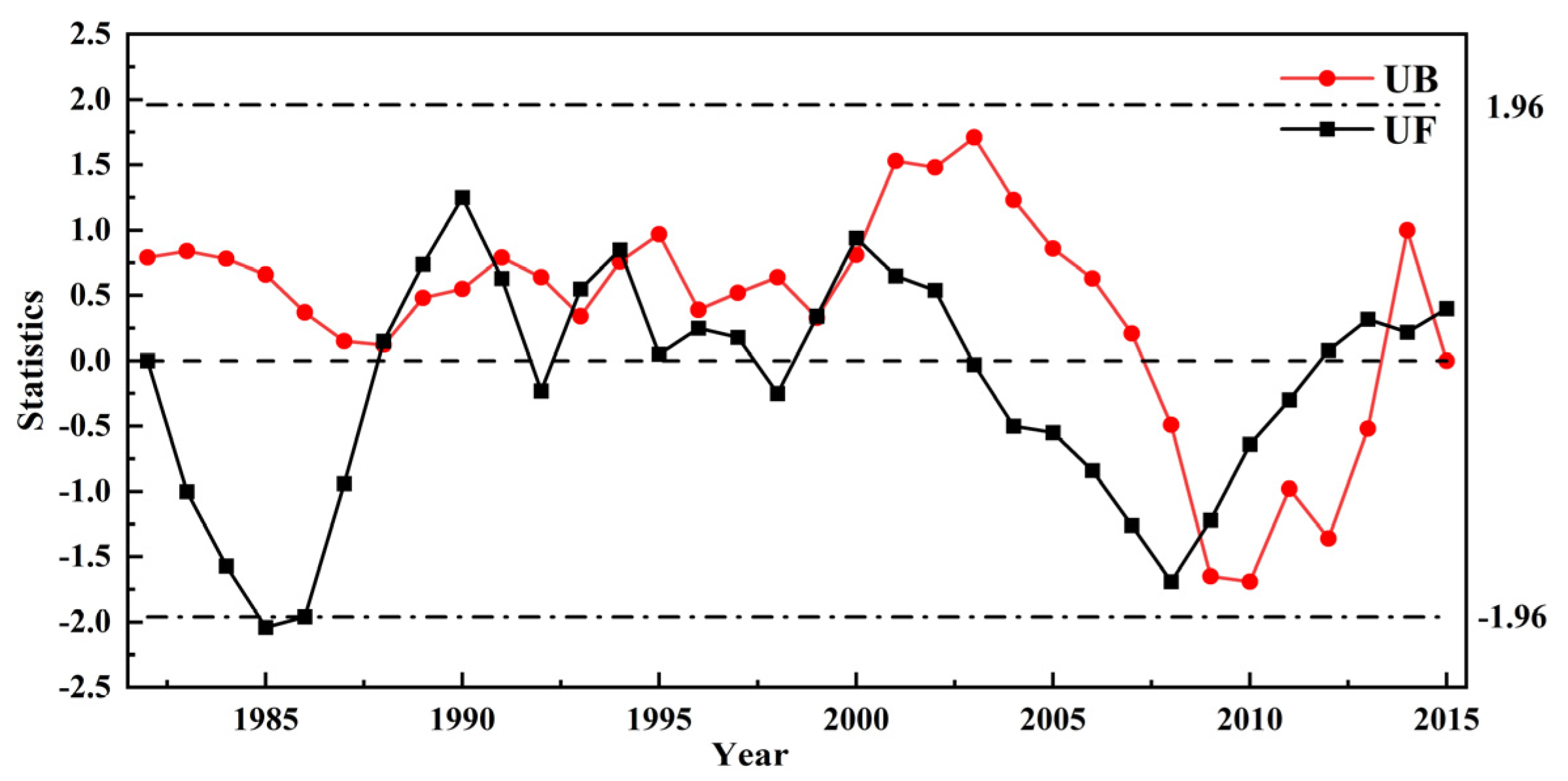
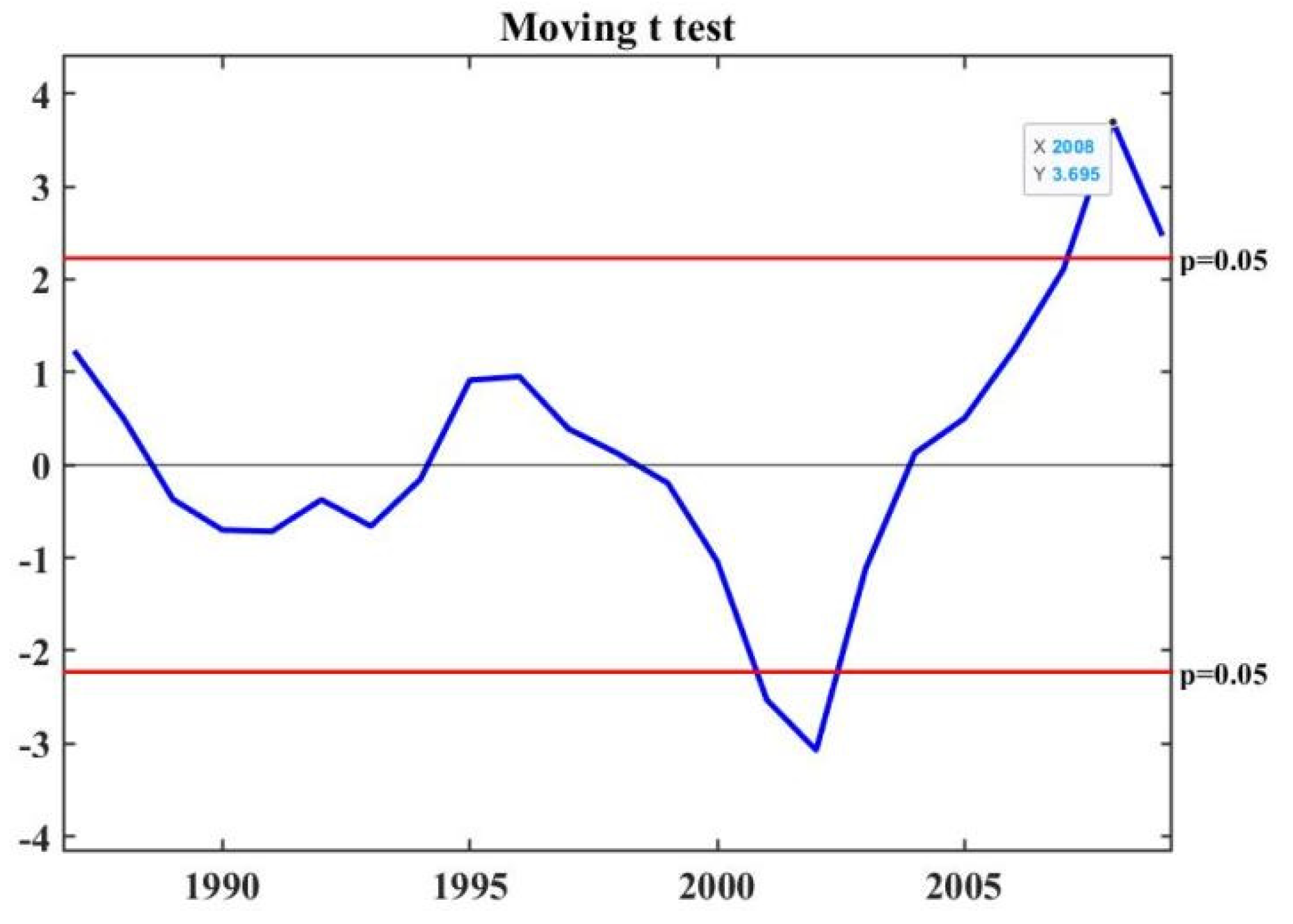
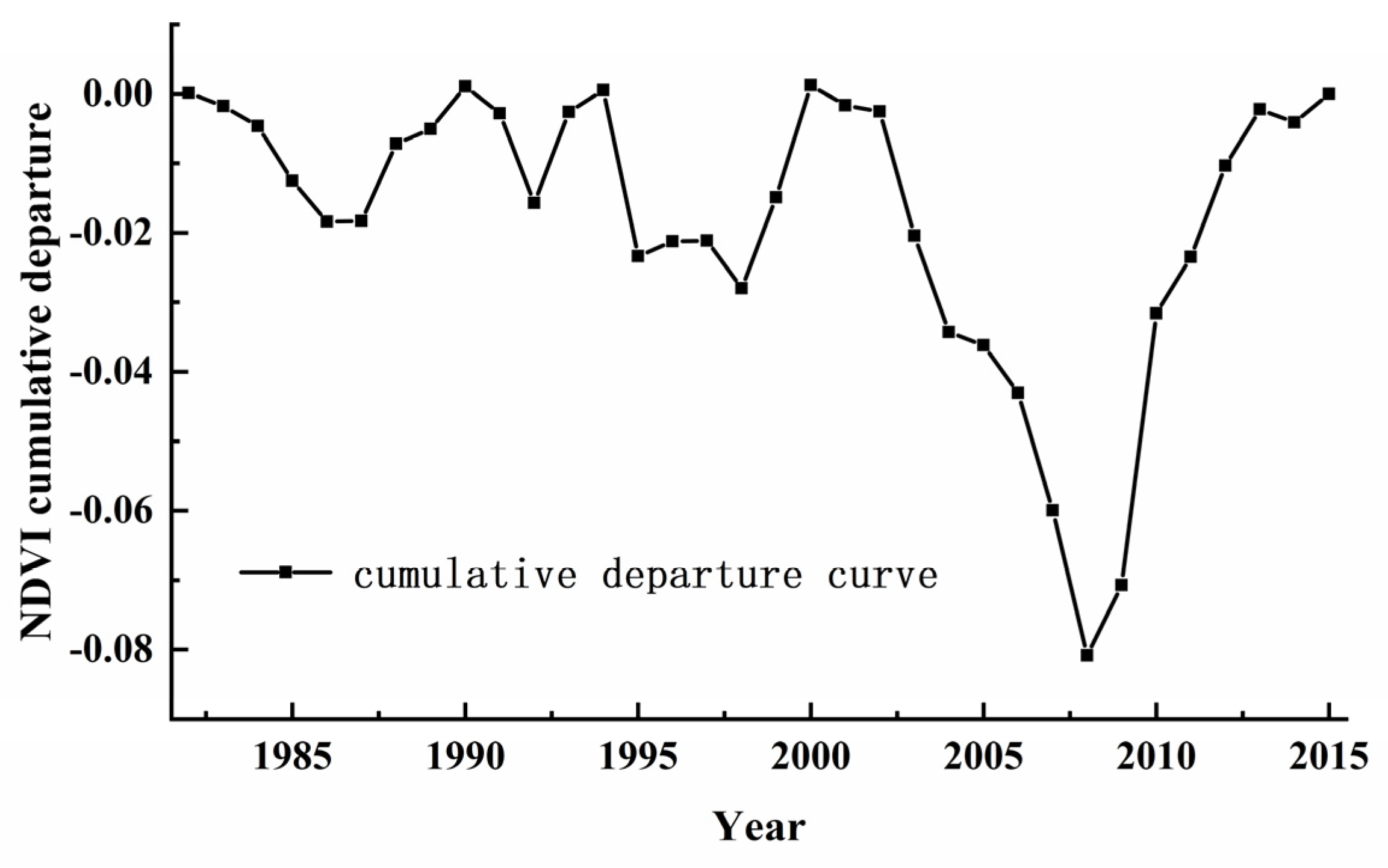
| Type | Detection Factors | Index | Unit | Type | Detection Factors | Index | Unit |
|---|---|---|---|---|---|---|---|
| Topography | X1 | Slope | ° | Climate | X7 | Annual mean temperature | °C |
| X2 | Aspect | ° | X8 | Annual precipitation | mm | ||
| X3 | Elevation | m | Human activity | X9 | GDP | 10,000 yuan/km2 | |
| Soil | X4 | Soil type | - | X10 | Population density | people/km2 | |
| Vegetation | X5 | Vegetation type | - | X11 | Land use type | - | |
| Landform | X6 | Landform type | - |
| Foundation | Interaction |
|---|---|
| q (X1∩X2) < Min [q (X1), q (X2)] | Nonlinear weakening |
| Min [q (X1), q (X2) < q (X1∩X2) < Max (q (X1), q (X2)] | Univariate weakening |
| q (X1∩X2) > Max [q (X1), q (X2)] | Bivariate enhancement |
| q (X1∩X2) = q (X1) + q (X2) | Independent |
| q (X1∩X2) > q (X1) + q (X2) | Nonlinear enhancement |
| NDVI Grade. | ≤0.2 | 0.2–0.4 | 0.4–0.6 | 0.6–0.8 | >0.8 | Total in 2015 | Shifted-In |
|---|---|---|---|---|---|---|---|
| ≤0.2 | 52,380.30 | 3574.52 | 28.62 | 40.13 | 0.00 | 56,023.57 | 3643.27 |
| 0.2–0.4 | 15,250.20 | 79,604.60 | 7079.04 | 67.18 | 0.00 | 102,001.02 | 22,396.42 |
| 0.4–0.6 | 136.95 | 11,649.30 | 75,441.70 | 15,042.10 | 21.39 | 10,2291.44 | 26,849.74 |
| 0.6–0.8 | 0.00 | 234.22 | 9102.26 | 81,869.60 | 14,528.30 | 105,734.38 | 23,864.78 |
| >0.8 | 0.00 | 0.00 | 40.50 | 4214.91 | 10,510.80 | 14,766.21 | 4255.41 |
| Total in 1982 | 67,767.45 | 95,062.64 | 91,692.13 | 101,233.92 | 25,060.49 | 380,816.63 | |
| Shifted-out | 15,387.15 | 15,458.04 | 16,250.43 | 19,364.32 | 14,549.69 | ||
| Variation | −11,743.88 | 6938.38 | 10,599.31 | 4500.46 | −10,294.28 | ||
| Percentage (%) | −3.08 | 1.82 | 2.78 | 1.18 | −2.70 |
| Change Trend | Gradient | Area/km2 | Percentage (%) |
|---|---|---|---|
| Significant degradation | −0.0107–−0.0024 | 5511.50 | 1.44 |
| Moderate degradation | −0.0024–−0.0010 | 40,788.80 | 10.65 |
| Slight degradation | −0.0010–−0.0002 | 79,577.90 | 20.78 |
| Basically unchanged | −0.0002–0.0005 | 112,079.00 | 29.27 |
| Slight improvement | 0.0005–0.0013 | 94,305.40 | 24.63 |
| Moderate improvement | 0.0013–0.0026 | 44,664.90 | 11.66 |
| Significant improvement | 0.0026–0.0179 | 6025.25 | 1.57 |
| Factors | X1 | X2 | X3 | X4 | X5 | X6 | X7 | X8 | X9 | X10 | X11 |
|---|---|---|---|---|---|---|---|---|---|---|---|
| q value | 0.141 | 0.055 | 0.350 | 0.147 | 0.409 | 0.216 | 0.463 | 0.550 | 0.088 | 0.204 | 0.244 |
| p value | 0.000 | 0.000 | 0.000 | 0.000 | 0.000 | 0.000 | 0.000 | 0.000 | 0.000 | 0.000 | 0.000 |
| Factors | X1 | X2 | X3 | X4 | X5 | X6 | X7 | X8 | X9 | X10 | X11 |
|---|---|---|---|---|---|---|---|---|---|---|---|
| X1 | |||||||||||
| X2 | Y | ||||||||||
| X3 | Y | Y | |||||||||
| X4 | N | Y | Y | ||||||||
| X5 | Y | Y | Y | Y | |||||||
| X6 | Y | Y | Y | Y | Y | ||||||
| X7 | Y | Y | Y | Y | Y | Y | |||||
| X8 | Y | Y | Y | Y | Y | Y | Y | ||||
| X9 | Y | Y | Y | Y | Y | Y | Y | Y | |||
| X10 | Y | Y | Y | Y | Y | N | Y | Y | Y | ||
| X11 | Y | Y | Y | Y | Y | Y | Y | Y | Y | Y |
| X1 | X2 | X3 | X4 | X5 | X6 | X7 | X8 | X9 | X10 | X11 | |
|---|---|---|---|---|---|---|---|---|---|---|---|
| X1 | 0.141 | ||||||||||
| X2 | 0.176 | 0.055 | |||||||||
| X3 | 0.473 | 0.415 | 0.350 | ||||||||
| X4 | 0.258 | 0.164 | 0.461 | 0.147 | |||||||
| X5 | 0.468 | 0.431 | 0.599 | 0.468 | 0.409 | ||||||
| X6 | 0.265 | 0.255 | 0.548 | 0.356 | 0.507 | 0.216 | |||||
| X7 | 0.522 | 0.532 | 0.611 | 0.597 | 0.660 | 0.535 | 0.463 | ||||
| X8 | 0.583 | 0.585 | 0.680 | 0.610 | 0.677 | 0.605 | 0.679 | 0.550 | |||
| X9 | 0.227 | 0.149 | 0.376 | 0.247 | 0.487 | 0.301 | 0.487 | 0.586 | 0.088 | ||
| X10 | 0.304 | 0.266 | 0.485 | 0.371 | 0.558 | 0.352 | 0.527 | 0.607 | 0.352 | 0.204 | |
| X11 | 0.324 | 0.263 | 0.501 | 0.324 | 0.492 | 0.369 | 0.573 | 0.628 | 0.334 | 0.360 | 0.244 |
| Factors | Suitable Range or Types | NDVI |
|---|---|---|
| Slope (°) | >25 | 0.610 |
| Aspect | North, Northeast, East, West, Northwest | 0.484 |
| Elevation (m) | 3446–3851 | 0.743 |
| Soil type | Semi-leached | 0.689 |
| Vegetation type | Coniferous forest, broadleaf forest, scrub | 0.712 |
| Landform type | Medium undulating mountains | 0.601 |
| Annual mean temperature (°C) | 1.65–3.82 | 0.681 |
| Annual precipitation (mm) | 578–708 | 0.770 |
| GDP (10,000 yuan/km2) | 12–37, 104–242 | 0.609 |
| Population density (people/km2) | 74.95–94.31 | 0.699 |
| Land use type | Forest land, construction land | 0.743 |
| Zones | 1 | 2 | 3 | 4 | 5 | 6 | 7 | 8 | 9 |
|---|---|---|---|---|---|---|---|---|---|
| 1 | |||||||||
| 2 | Y | ||||||||
| 3 | Y | Y | |||||||
| 4 | Y | Y | Y | ||||||
| 5 | Y | Y | Y | Y | |||||
| 6 | Y | Y | Y | Y | Y | ||||
| 7 | Y | Y | Y | Y | Y | Y | |||
| 8 | Y | Y | Y | Y | Y | Y | N | ||
| 9 | Y | Y | Y | Y | Y | Y | Y | Y | |
| NDVI | 0.310 | 0.282 | 0.329 | 0.462 | 0.572 | 0.664 | 0.696 | 0.691 | 0.771 |
| Zones | 1 | 2 | 3 | 4 | 5 | 6 | 7 | 8 | 9 |
|---|---|---|---|---|---|---|---|---|---|
| 1 | |||||||||
| 2 | N | ||||||||
| 3 | Y | Y | |||||||
| 4 | Y | Y | Y | ||||||
| 5 | Y | Y | Y | Y | |||||
| 6 | Y | Y | Y | Y | Y | ||||
| 7 | Y | Y | Y | Y | Y | Y | |||
| 8 | Y | Y | Y | N | Y | Y | Y | ||
| 9 | Y | Y | Y | Y | Y | Y | Y | Y | |
| NDVI | 0.260 | 0.275 | 0.294 | 0.482 | 0.598 | 0.682 | 0.659 | 0.497 | 0.553 |
| Zones | 1 | 2 | 3 | 4 | 5 | 6 | 7 | 8 | 9 |
|---|---|---|---|---|---|---|---|---|---|
| 1 | |||||||||
| 2 | Y | ||||||||
| 3 | Y | N | |||||||
| 4 | Y | N | N | ||||||
| 5 | Y | Y | Y | Y | |||||
| 6 | Y | Y | Y | Y | Y | ||||
| 7 | Y | Y | N | Y | Y | Y | |||
| 8 | Y | Y | N | Y | Y | Y | Y | ||
| 9 | Y | Y | N | Y | Y | Y | N | N | |
| NDVI | 0.159 | 0.714 | 0.583 | 0.702 | 0.229 | 0.270 | 0.544 | 0.368 | 0.466 |
| Zones | 1 | 2 | 3 | 4 | 5 | 6 | 7 | 8 | 9 |
|---|---|---|---|---|---|---|---|---|---|
| 1 | |||||||||
| 2 | Y | ||||||||
| 3 | Y | Y | |||||||
| 4 | Y | Y | Y | ||||||
| 5 | Y | Y | Y | Y | |||||
| 6 | Y | Y | Y | Y | Y | ||||
| 7 | Y | N | Y | Y | Y | Y | |||
| 8 | N | Y | Y | Y | Y | Y | Y | ||
| 9 | Y | Y | Y | Y | Y | Y | Y | Y | |
| NDVI | 0.297 | 0.418 | 0.744 | 0.704 | 0.550 | 0.457 | 0.396 | 0.303 | 0.253 |
Publisher’s Note: MDPI stays neutral with regard to jurisdictional claims in published maps and institutional affiliations. |
© 2021 by the authors. Licensee MDPI, Basel, Switzerland. This article is an open access article distributed under the terms and conditions of the Creative Commons Attribution (CC BY) license (https://creativecommons.org/licenses/by/4.0/).
Share and Cite
Gao, S.; Dong, G.; Jiang, X.; Nie, T.; Yin, H.; Guo, X. Quantification of Natural and Anthropogenic Driving Forces of Vegetation Changes in the Three-River Headwater Region during 1982–2015 Based on Geographical Detector Model. Remote Sens. 2021, 13, 4175. https://doi.org/10.3390/rs13204175
Gao S, Dong G, Jiang X, Nie T, Yin H, Guo X. Quantification of Natural and Anthropogenic Driving Forces of Vegetation Changes in the Three-River Headwater Region during 1982–2015 Based on Geographical Detector Model. Remote Sensing. 2021; 13(20):4175. https://doi.org/10.3390/rs13204175
Chicago/Turabian StyleGao, Siqi, Guotao Dong, Xiaohui Jiang, Tong Nie, Huijuan Yin, and Xinwei Guo. 2021. "Quantification of Natural and Anthropogenic Driving Forces of Vegetation Changes in the Three-River Headwater Region during 1982–2015 Based on Geographical Detector Model" Remote Sensing 13, no. 20: 4175. https://doi.org/10.3390/rs13204175
APA StyleGao, S., Dong, G., Jiang, X., Nie, T., Yin, H., & Guo, X. (2021). Quantification of Natural and Anthropogenic Driving Forces of Vegetation Changes in the Three-River Headwater Region during 1982–2015 Based on Geographical Detector Model. Remote Sensing, 13(20), 4175. https://doi.org/10.3390/rs13204175





